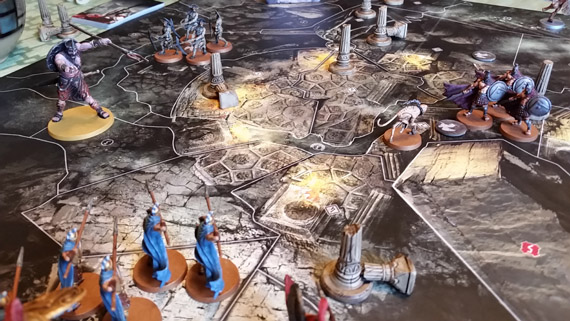In some ways I feel like the publishers of Mythic Battles: Pantheon took advantage of me. The game's Kickstarter campaign launched soon after they had delivered their phenomenal Conan board game, so I was flush with excitement over how great Conan was, and regret that I had only backed the core game and a few small expansions. That, combined with some compelling playthrough videos on Beasts of War and the infectious enthusiasm of their PR man Leo, made diving into this game a no-brainer.
It's a great example of an emerging category of hybrid games combining elements of adventure board games and tactical skirmishers. At its core, MB:P is a battle between two or more players' assembled forces of gods, heroes and monsters from Greek mythology, using movement around a battlefield to gain advantage and dice to score hits on opposing miniatures. However, it borrows two important board game elements to keep things interesting.
One is the use of a printed board to enable area-based movement, eliminating the need for fiddly tape measures. The game comes with several beautifully illustrated boards depicting different environments, with movement spaces clearly marked. Each space includes a symbol identifying what type of terrain it is and how many miniatures can occupy the space. The symbol also doubles as a simple line-of-sight indicator, making it easy to tell whether opposing miniatures can shoot at each other.
The other board game element MB:P uses is "activation cards" to determine when miniatures can move and attack, and this is where I think this game really shines. At the start of the game players assemble a deck of cards based on the characters they have included in their army, plus some "Art of War" cards that enable different special effects. In order to move a particular miniature, the player must first play that miniature's card from their hand. This forces players to think on their feet, formulating their tactics based on the cards they have available, rather than using the same strategy over and over again.
The default game involves collecting tokens called Omphalos from the board, which add a strategy card to the player's deck once collected. This makes even a basic game more interesting than your standard "rush to the middle and fight" skirmish, since collecting a majority of Omphalos is one of the main ways to win the game. Additionally, the rule book details a wide array of scenario-based games that give different objectives and victory conditions, as well as several multi-game campaigns where the result of one game affects the next.
It's a great rules system, and it's coupled with some gorgeous visual elements. The artwork on the cards and boards is stunning, and the miniatures are just amazing. They're plastic, but they hold an incredible amount of detail, and they are an absolute joy to paint. The manufacturing even involved a method using different types of plastic, with spears and swords made out of a harder material so that they stay straight. Any miniature painter who's had to straighten out a curvy spear on a plastic model will know what I'm talking about.
The only thing I can think of to complain about is that the sheer amount of content can be overwhelming, with close to 200 miniatures and over 80 scenarios to play with. All in all, that's probably not a bad problem to have.
Rating: 5 (out of 5) This game has the surprisingly rare combination of great miniatures coupled with a simple but compelling rules system.
- Mythic Battles: Pantheon official website
- Mythic Battles: Pantheon on BoardGameGeek


